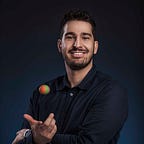Why Industrial Design made me a better UX Designer
The physical space
My core studies come from the field of Industrial design and more accurately from Product design. As a student I remember very clear that from Day 1 they used to tell us that:
“All design is human-centered and solves a problem. If it’s not human-centered and doesn’t solve a problem, then it’s not design. And if it’s not design, it’s art”.
Throughout the product design studio courses we were taught how to explore the relationship between people and objects. We analyzed physical qualities, ergonomics, semantics, and function. We also considered aesthetics and beauty using Gestalt principles.
As product designers when we referred to User Experience we were talking about a big umbrella that covered Ergonomy, Ethnography Research, User Center Design, User Research, Problem Space Research, Data Gathering etc. Product designers cannot design any object at all that doesn’t focus on the users and their needs.
Of course their needs go hand in hand with the environment in which they use the object. From an Industrial Design point of view it is/was common sense to design for the impact that the artifact/object/system is intended to have in a person’s life and the term experience design was never used compared with the today’s buzzword User Experience Design.
The Digital Shift
So what happens when we move to the digital realm? In today’s industry there’s a growing trend when it comes to UX designers. What I quickly discovered was the fact that both UX Designers and Industrial Designers share a passion to make the world a better place for people. And that’s a very good start.
For me having the background of an industrial designer which means always designing for a specific purpose driven by hard data in order to make a useful product was the same as being a UX designer who would not only strive to have every detail about the end user but also get his hands dirty and design a digital product pleasing to the human eye. In short as Mark Baskinger puts it in his article “From Industrial Design to User Experience : The heritage and evolving role of experience-driven design” :
“both roles bake their own cake and decorate it”.
That’s why it was so appealing to me. At the beginning I had to focus on the tools for UI and I don’t mean the software but rather the fundamentals of visual communication such as typography, layout, white space (negative space) etc. When it came to UX the tools and the thought process were already in place. User experience methods have pretty much remained the same.
When you are an industrial designer you conduct usability tests with your prototype object and test it with users based on metrics. You do the same thing in digital. Of course there are different things to have in mind but the concept remains the same. Just to make it clear I don’t imply that user experience in digital design is only about usability. It is a part of it. So I came to understand that most people, if not all, that practice the role of the UX/UI Designer come from various backgrounds such as Industrial Design, Marketing, Psychology, Anthropology and many others. It is the people that design industry call Multidisciplinary designers.
The Swiss army knife of design that can tackle multiple design problems, adapting to the project and company needs. They are the guys that most often land leadership roles due to their understanding of how each role is different and their ability to associate workload effectively as well as take appropriate decisions based on each individual department. Often they bring to the table powerful knowledge that can make products better, cut down delivery time, iteration time, have channels through multiple departments and land a hand to fellow designers if they’re having problems.
Conclusion
User experience lies between aesthetics and science and requires both extremely acute analytical thinking and creativity. It didn’t matter when I changed my tools from a 3D modeling software and a rendering machine to a photo editing or a vector software. What mattered was that I always carried in mind that design must have the user placed in the center of the process with purpose of solving a specific problem. This is what design is about. And as Terry Irwin, former principal and creative director of the San Francisco office of MetaDesign and now head of the School of Design at Carnegie Mellon said, this is the century for design. No other discipline is as equipped to address current problems, forecast a new future, and shift conventional thinking, behaviors, and understanding of the world.
